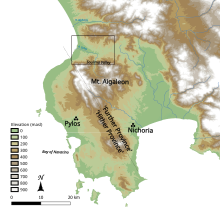Nancy Wilkie
[3] The expedition had grown out of field surveys conducted by Bill McDonald from 1953, joined by Richard Hope Simpson from 1959 and, from 1961, by a wider range of specialists under the UMME name.
[10] Reviewing the publication in the American Journal of Archaeology, the archaeologist Patrick M. Thomas called Wilkie's chapter on the Nichoria tholos "a fine piece of scholarship, and … a reminder that much can be done even with the 'scraps' of a plundered tomb".
[11] After Wilkie's death in 2021, Jack Davies listed the publication of the results of the excavation of Nichoria as one of her chief achievements.
[13] The expedition carried out field survey and discovered numerous ancient sites in western Phokis and the Kephissos Valley.
[14] Publication and study of the expedition's findings continued into the 1990s: Wilkie spent part of the 1998–1999 season cataloguing the materials in the Amfissa museum, in collaboration with John Rosser.
The expedition surveyed around 800 square kilometres (310 sq mi) of area, and has been called "the most significant archaeological exploration of the region".
[18] The work at Kom Dahab began with the collection of surface potsherds and the digging of trial trenches,[19] and discovered a kiln through the use of magneometry in 1982.
[22] In a similar vein to the University of Minnesota Messenia Expedition, the Grevena Project took a diachronic approach and included study of the modern culture and farming practises of the region, carried out by Stanley Aschenbrenner (with whom Wilkie had worked at Nichoria)[8] as well as Harold Coster and Claudia Chang.
She subsequently joined the national governing board of the AIA as an academic trustee in 1989,[2] and served on its committees for professional responsibilities, Eastern Europe and capital campaigns.
[24] Wilkie was a co-founder of the US Committee of Blue Shield International, an organisation dedicated to the protection of cultural heritage from war and natural disaster.
[26] She was a keen sailor, owning a boat on Lake Superior named Tiamat, after the Babylonian goddess of the sea.
[24] In 2010, she was chosen as the Charles Eliot Norton Memorial lecturer, an appointment described by the AIA as "one of the highest honors [it] can bestow".


